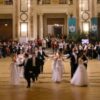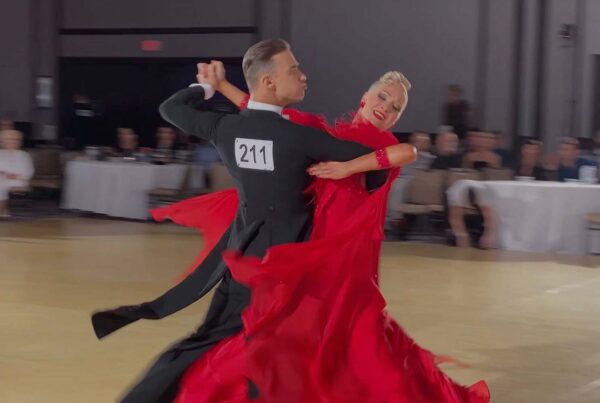It’s a shame that a sport which is so much about harmony and togetherness can be so divided by politics. It’s even worse when that divisiveness takes place within the same national borders. But such is the case.
This post is intended to give a better understanding of what’s currently going on between USA Dance and the NDCA, as well as the tensions between the WDC and WDSF (formerly IDSF). It isn’t intended to take sides or assign blame, because each side has its own reasons for where it is going, reasons made by and on behalf of intelligent people with a passion for the ballroom dance world. We can each decide where we stand in the picture, but here are the facts as I understand them.
Foundation of today’s issues
The problems we’re facing today have their origin in the IDSF’s goal of having DanceSport be recognized as an Olympic sport. To be sure, it was a noble goal, based not only on the athleticism of dance, but also on the idea that sports gets more national funding in most countries than the arts do. In Germany, where DanceSport was recognized by the government as a “sport” back in 1964, ballroom dancing has progressed in a spectacular way.
The IOC (International Olympic Committee) has insisted that for any sport to be taken seriously as an Olympic sport, it must be governed by one worldwide body.
With multiple governing groups, there is too much confusion. How can the public understand when there are multiple world champions? Other sports have gone through similar issues. At one time, there were so many boxing organizations that there were 9 world champions at the same time. That’s simply bad for any field.
So, the IDSF embarked on a strategy to become the worldwide authority for all ballroom dance competition.
Unfortunately, this led to a number of challenges as the IDSF began to ban couples from competing in unregistered events. Many people didn’t like to be told where they could or couldn’t compete, but in essence this strategy was a successful one, with surprisingly few issues overall. The IDSF grew substantially, organizing many top amateur competitions around the world and it became the undisputed leader in amateur DanceSport.
Amateur League
Things may have yielded a fairly stable peace had this been left alone, the IDSF representing all the world’s amateurs and the WDC representing all the professionals, but it was not to be.
As tension heated up over the bans, the WDC launched its own “Amateur League” to create an alternate environment in which dancers who didn’t want to be restricted could compete. Naturally, this challenge would not sit well with the IDSF leadership and it inflamed the tensions even more.
IDSF creates Professional division
Around this time, the IDSF created its own professional League, the IPDSC. This division would license professionals and use them to judge IDSF events, rather than using WDC members as it had in the past. The IDSF/WDSF uses a randomized computer program to choose judges to avoid the appearance of favoritism. Of course, most top WDC judges would get certified by the IDSF while retaining their WDC membership and thus were available to judge IDSF events around the world.
Eventually, the IDSF absorbed the IPDSC into the organization to create one large body instead of using separate organizations.
As top amateurs turned professional, they were pressured to stay within the IDSF “family” by joining the IDSF’s professional division rather than leaving the IDSF to join the WDC. The WDC was the world leader in professional recognition, and offered great status and opportunity for anyone turning pro, so most top dancers would join the WDC after turning pro. There were complaints that some who moved to the WDC were then ostracized by the IDSF, creating additional tensions.
Enter the USA
In early 2011, USA Dance, an amateur body governing all amateur competition in the USA, came under new pressure by the WDSF to be involved with the professional division of the WDSF within the United States. But there already was a long established professional organization in the US, the NDCA (National Dance Council of America), and this organization had been for a time a member of the IPDSC.
As a news release by the NDCA clarified on July 15, 2011, “The NDCA was a member of the IPDSC under the registered name of ‘Dance Sport America.’ In October 2009, the IDSF completely absorbed the IPDSC into its main body, thereby making it the IDSF professional division: Dance Sport America resigned immediately.”
This new directive created a confrontation between the NDCA and USA Dance. Some argue that it’s an issue between NDCA and WDSF but that’s not quite the case, because NDCA doesn’t actually have a direct relationship with the WDSF at this time. As their news release of July 15 points out, “to say that this current issue is one between NDCA and WDSF is untrue; NDCA has no relationship with WDSF. USA Dance is its member, with whom it has a relationship; its professional relationship is with WDC.”
USA Dance and NDCA had lived in pleasant harmony for decades, working well together and never stepping on each other’s toes. A long-standing written agreement between them, one that was clarified in the NDCA’s latest rule book, required USA Dance to stay out of the professional realm. The actions of USA Dance, responding to the pressure from the WDSF, flew directly in the face of this agreement.
The NDCA responded by banning USA Dance and ending IDSF events in the US. As a result, NDCA judges can’t adjudicate USA Dance events. The WDSF responded by banning NDCA judges from its events in the US, even pulling the US judges from the World Championships in Brooklyn just one week before the event was held. In addition, the WDSF banned the world’s top amateur couples from entering the WDSF/IDSF Grand Slam event in the USA.
There are not a huge number of events organized by USA Dance (the regional championships are the primary amateur-only events in the country). A number of large NDCA-organized competitions (like Embassy Ball and Ohio Star Ball) will no longer include WDSF events in their schedule as they had in the past. This may not have an immediate effect in the success of these events, but the effect will be felt. Without European couples coming to these events, the talent pool will not be sufficient to create a world-class competition environment.
USA Dance events, now having no US judges to adjudicate them, will require WDSF judges to be imported from overseas. This will significantly increase the cost for organizers, and likely means they won’t be happening. How that affects the ability of US amateur couples to qualify for the national championships remains to be seen.
What now?
We don’t really know where this will lead, of course. The WDSF has already responded by banning NDCA judges from participating in IDSF events. In the past they could hold both IPDSC and NDCA certification, but it seems that’s no longer being recognized (correct me if I’m wrong). With many of the world’s top judges now living in and representing the USA, there will no doubt be some kind of impact from this ban. In addition, top judges representing Great Britain and other countries as part of the WDC will also feel the effect of this ban as it will probably extend further.
In a recent interview published in Dance Beat World, WDSF president Carlos Frietag said that while Blackpool and UK Open were not banned by the WDSF/IDSF at this time, he hinted that such a ban was coming. Given what’s happened in the past few weeks, it will probably come sooner rather than later.
Where does Canada fit into this mess? Canada’s professionals are governed by the CDF (Canadian DanceSport Federation) which has a strong relationship with the WDSF. My understanding is that the CDF fills the WDSF pro organization requirement for Canada because the WDC runs a different, competing organization, the CDDSC, which lost much of its membership when all of this began and currently serves very little function in the Canadian DanceSport scene.
For now, Canadian athletes are permitted to enter NDCA events (which represent most of the US competitions), but how long that truce will last is anyone’s guess. Canada’s amateur body, CADA, has agreements with both USA Dance and the NDCA. It appears that eventually they will have to choose an alliance and the WDSF is likely to require that allegiance to be with USA Dance rather than NDCA. How they will respond if such a demand is made is anyone’s guess.
Even in a best case scenario, Canadian DanceSport athletes will suffer because they won’t have easy (read “affordable”) access to world-class couples to compete against. With no IDSF events in the USA, and perhaps no events on the continent that European champions can even attend, there will be little opportunity to be compared against the world’s best. Fortunately, there are some IDSF events in Canada. The travel costs are high, but these will gain more awareness and status with the challenges taking place south of the 49th Parallel.
Stay tuned.














We face the same problem in South Africa, where we have two dance federations, means two SA Champs. Which means nothing. How can we solve this problem?
Thanks for sharing the information. Dancing can help in significantly reducing stress and depression, improving your memory & help to stay always fit. Thank you.